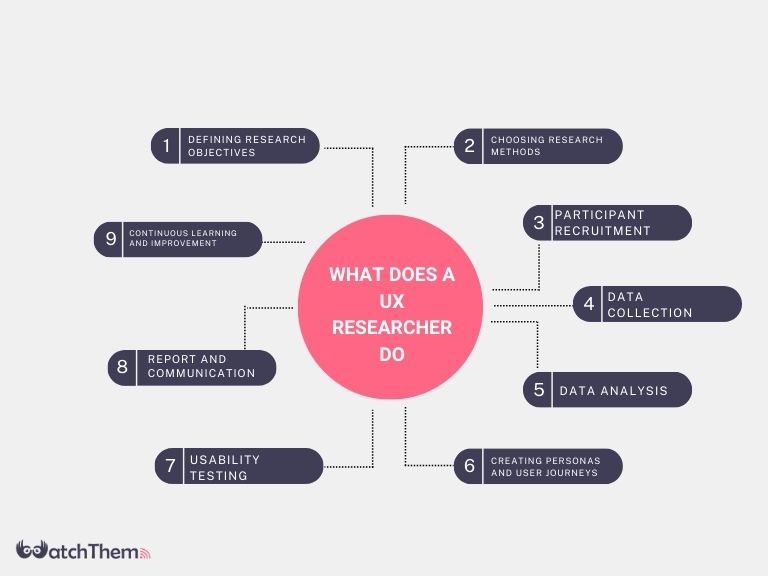Page Contents
Have you ever wondered about the architects behind seamless user experiences, the masterminds who delve deep into user behavior to enhance the digital landscape? That’s what a UX researcher does!
The UX researcher plays a crucial role in creating products that not only look good but also meet user needs intuitively. If you’re curious about this role or are planning to become one and navigate the dynamic field of user experience and CRO, you’re in the right place.
In this article, we’ll provide everything you need to know, including UX researcher salary, how to become one, and the skills required to be successful in the field. Additionally, if you’re wondering whether you need to hire a UX researcher, you’ll find your answer here!
What Is a UX Researcher
A UX (User Experience) researcher is a professional who focuses on understanding and improving the experience that users have with a product, service, or system. The primary goal of a UX researcher is to advocate for the needs and preferences of users by gathering and analyzing data related to user behavior, attitudes, and expectations.
UX researchers employ a variety of research methods to collect data, including interviews, surveys, usability testing, and observational studies. By understanding user needs and expectations, they provide valuable insights that help design teams create products that align more closely with user preferences.
In essence, a UX researcher acts as an advocate for the end-users, ensuring that their perspectives are considered throughout the design and development lifecycle. The goal is to enhance the overall user experience, making products more intuitive, efficient, and enjoyable to use.
Now, you might wonder ‘What is UX researcher job description?’. We’ll elaborate more in the following!
What Does a UX Researcher Do
UX researchers play an important role in ensuring that products are not only functional but also enjoyable and effective for users. Below are the key responsibilities and tasks that a UX researcher typically undertakes:


1. Defining Research Objectives
- Purpose: Before conducting any research, a UX researcher works closely with stakeholders to define clear objectives. These objectives guide the research process and help in gathering relevant insights.
- Collaboration: Collaboration with product managers, designers, and developers to align research goals with the overall project vision.
2. Choosing Research Methods
- Selection Criteria: Based on the defined objectives, a UX researcher selects appropriate research methods. Common methods include interviews, surveys, usability testing, and contextual inquiry.
- Mixing Methods: Combining quantitative and qualitative methods to gain a comprehensive understanding of user experiences.
3. Participant Recruitment
- Target Audience: Identifying and recruiting participants who represent the intended user base. This involves creating personas and ensuring diverse representation.
- Ethical Considerations: Following ethical guidelines to obtain informed consent and protect participant privacy.
4. Data Collection
- Interviews and Surveys: Conducting one-on-one interviews or distributing surveys to gather qualitative and quantitative data on user preferences, pain points, and behaviors.
- Observation: Directly observing users in their natural environment or during product interactions to understand their context and behaviors.
5. Data Analysis
- Coding and Categorization: Analyzing qualitative data by coding and categorizing responses to identify patterns and themes.
- Statistical Analysis: Employing statistical tools for quantitative data to derive meaningful insights and validate hypotheses.
6. Creating Personas and User Journeys
- Persona Development: Using research findings to create user personas that represent different segments of the target audience.
- User Journey Mapping: Mapping out the end-to-end user experience to identify pain points and areas for improvement.
7. Usability Testing
- Testing Prototypes: Conducting usability tests to evaluate the effectiveness and efficiency of prototypes or existing products.
- Iterative Feedback: Providing feedback to designers and developers, and iterating on designs based on user testing results.
8. Report and Communication
- Documentation: Creating detailed reports summarizing research findings, insights, and recommendations.
- Presentation: Communicating findings to cross-functional teams, stakeholders, and clients, ensuring a shared understanding of user needs.
9. Continuous Learning and Improvement
- Feedback Loop: Establishing a continuous feedback loop, incorporating insights from ongoing research into the product development process.
- Staying Informed: Keeping up with industry trends, new research methods, and technological advancements to enhance the quality and relevance of research activities.
How to Become a UX Researcher
Becoming a UX researcher involves a combination of education, skills development, and practical experience. Before learning about UX researcher salary, here’s a step-by-step guide to help you become a successful one:
#1 Get the Right Education
To become a UX researcher, start by getting the right education. You can either pursue a bachelor’s degree in a related field like psychology, sociology, or even design.
Alternatively, you can explore specialized courses in UX, human-computer interaction, or psychology. Look for programs that provide a solid foundation in understanding user behavior and interaction.
#2 Build Your Skills
Developing essential skills is crucial. Learn various research methods such as usability testing, surveys, and interviews. Also, focus on data analysis skills using tools like Excel or statistical software.
In the following, we’ll elaborate more on the skills you need to acquire.
#3 Show Your Work
Create a portfolio showcasing your skills and projects. Explain your role in each project, the methods you used, and how your research influenced the final product.
This portfolio serves as a tangible representation of your abilities and helps potential employers understand your practical experience.
#4 Connect with Others
Networking is essential in any industry. Attend conferences, seminars, and local meetups to meet professionals in the UX field. Join online communities on platforms like LinkedIn and Twitter to engage in discussions, learn from others, and stay updated on industry trends.
#5 Apply for Jobs
Once you feel confident in your skills, have built a solid portfolio, and are familiar with the UX researcher job description, start applying for UX researcher positions. Tailor your resume to highlight your relevant experiences and skills. Look for opportunities that align with your interests and career goals.
#6 Build Your Professional Presence
Create a professional LinkedIn profile that reflects your skills, education, and experiences. Connect with professionals in the UX industry, and actively participate in discussions and forums.
Building a strong online presence can enhance your visibility and open up more opportunities.
#7 Keep Improving
UX is an evolving field, so always look for ways to improve. Seek feedback on your work and use it as a tool for growth. Be open to learning from every project, and embrace the iterative nature of UX design and research. The more you improve, the more valuable you become in the field.
What Skills Are Required for UX Researchers
In UX research, being successful means having a mix of skills that sets you apart from others in the field. Let’s take a closer look:
Technical Skills
- Research Methods: Proficiency in various research methods, such as surveys, interviews, and usability testing, equips UX researchers to effectively gather valuable user insights.
- Data Analysis: The ability to analyze and interpret data collected during research enables researchers to derive meaningful conclusions and actionable recommendations.
- Prototyping and Wireframing: Competence in using tools like Sketch or Figma allows UX researchers to create visual representations of user interfaces, aiding in the design process.
- Usability Testing: Skills in setting up and moderating usability testing sessions are crucial for evaluating and improving a product’s user-friendliness.
- Information Architecture: Creating organized and intuitive information structures, demonstrated through tasks like developing sitemaps and user flows, is a key aspect of UX research.
Soft Skills
- Communication: Clear communication of research findings and insights to diverse stakeholders is essential for driving informed decision-making and facilitating collaboration.
- Empathy: Understanding and sharing the user’s perspective fosters the development of products that genuinely meet user needs.
- Critical Thinking: The ability to critically analyze information and make informed judgments is fundamental to identifying and addressing user experience challenges.
- Adaptability: Being flexible and open to change enables UX researchers to adjust their methods based on the evolving needs of a project.
- Team Collaboration: Effective collaboration with designers, developers, and other team members ensures a holistic and cohesive approach to UX research and design.
- Problem Solving: UX researchers need strong problem-solving skills to devise effective solutions based on user feedback and research insights.
- Time Management: Prioritizing tasks and meeting deadlines is crucial for managing multiple research projects simultaneously.
How Much Do UX Researchers Make
The average annual UX researcher salary in the USA is around $88,000 to $134,000. The salary range varies, with entry-level UX Researchers earning around $50,000 per year, junior UX Researchers making about $72,000 annually, mid-level UX Researchers averaging $105,000 per year, and senior UX Researchers earning around $130,000 per year.
However, In cities with a higher cost of living, such as San Francisco or New York, UX researcher salaries tend to be higher to accommodate the increased living expenses. Additionally, tech hubs or regions with a strong demand for UX professionals may offer more competitive salaries.
FAQs
So far, we tried to answer any questions you might’ve had regarding the UX researcher job description. Now, it’s time to go over some frequently asked questions:
Q1. Do UX Researchers Get Paid Well?
Yes, UX researchers are generally well-compensated. The average annual UX researcher salary in the USA is around $88,000 to $134,000. However, it’s important to note that salaries can vary based on factors such as experience level, location, and the demand for UX professionals in a particular region.
Q2. Is Becoming a UX Researcher Hard?
Becoming a UX researcher involves a combination of education, skills development, and practical experience. It requires a commitment to learning and staying informed about industry trends.
Through dedication, gaining pertinent knowledge, and refining essential skills, aspiring UX researchers can overcome the challenges of entering this field.
Conclusion
UX researchers are the architects of seamless digital experiences, focusing on understanding and enhancing user experiences. The journey to becoming a UX researcher involves education, skill development, and practical experience, emphasizing networking and continuous improvement.
In this guide, we elaborated on the required skills including technical expertise in research methods and data analysis, coupled with essential soft skills. The profession is rewarding, with average annual salaries ranging from $88,000 to $134,000 in the USA.
Your adventure as a UX researcher awaits—happy exploring!

